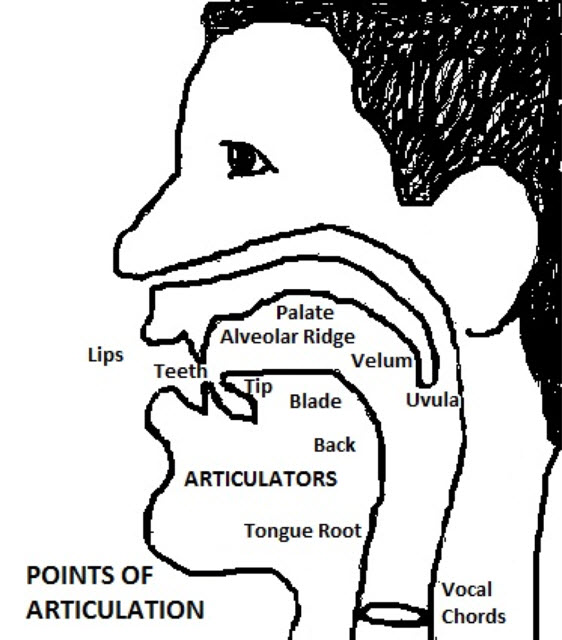12 KiB
အဓိပ္ပာယ်များ
၎င်းစာလုံး အဓိပ္ပာယ်များသည် ကျွန်ုပ်တို့က အသံတစ်ခုကို စာလုံးပုံစံပြောင်းလဲအသုံးပြုခြင်းနှင့် ၎င်းစကားလုံး၏တစ်စိတ်တစ်ပိုင်းကို ရည်ညွှန်းသည့် စာလုံးစစ် အဓိပ္ပာယ်စသည်ဖြင့် ကျွန်ုပ်တို့ ပြောဆိုရာတွင် အသုံးပြုသည့် အရာများဖြစ်ကြပါသည်။
ဗျည်း
အဆုတ်မှထွက်လာသောလေကို လျှာ၊ သွား၊ နှုတ်ခမ်း စသည်တို့၏ဖြတ်တောက်ခြင်း၊ တားဆီးခြင်းကို ခံရပြီးထွက်လာသော လူလုပ်သံများကို ဗျည်းဟုခေါ်သည်။ အက္ခရာထဲတွင်ရှိသော စာလုံးများသောအားဖြင့်သည် ဗျည်းအက္ခရာများဖြစ်ကြပါသည်။ ဗျည်းအက္ခရာအများစုတွင် အသံတစ်အသံထဲသာရှိကြပါသည်။
သရ
အဆုတ်ထဲမှလေသည်လေပြွန်ထဲမှတစ်ဆင့် လျှာ၊သွား၊ နှုတ်ခမ်းတို့၏ ပိတ်ဆို့ခြင်းမခံရဘဲ ပါးစပ်ထဲမှထွက်လာ၍ဖြစ်ပေါ်သော အသံများကို သရများဟုခေါ်ဆိုပါသည်။ (မြန်မာစာ၏ သာဓကများမှာ (အ၊အိ၊အု၊အေ၊အန်၊အော) တို့ဖြစ်ကြပါသည်။
အသံကွဲ
ဗျာများ၀န်ရံထားခြင်းရှိသည်ဖြစ်စေ မရှိသည်ဖြစ်စေ သရသံ တစ်သံထဲသာရှိသော စာလုံးတစ်လုံး၏ အပိုင်းဖြစ်ပါသည်။ အချို့စာလုံးများ၌ အသံကွဲတစ်မျိုးသာရှိကြပါသည်။
ထပ်ပေါင်းစာလုံး
စာလုံးတစ်လုံး၏ အဓိပ္ပာယ်ကိုပြောင်းလဲသွားစေနိုင်သော ထက်ပေါင်းထည့်သောစာလုံး။ ဤစာလုံးများသည် စကားလုံးများ၏ အရှေ့ သို့မဟုတ် အနောက် သို့မဟုတ် အလည်တွင် တည်ရှိနေနိုင်ပါသည်။
အရင်းအမြစ်
စာလုံးတစ်လုံး၏အခြေခံအကျဆုံးအပိုင်းဖြစ်ပါသည်။ ထပ်ပေါင်းစာလုံးများကိုဖယ်ရှားလိုက်လျှင် အရင်းအမြစ်စကားလုံး ကျန်ခဲ့မည်ဖြစ်ပါသည်။
Morpheme
အဓိပ္ပာယ်ရှိသော သေးငယ်သည့် စကားလုံးအစိတ်အပိုင်းမပါ၀င်ဘဲ အဓိပ္ပာယ်ရှိနေသောစာလုံး သို့မဟုတ် စားလုံး အစိတ်အပိုင်း။ (သာဓကအနေဖြင့် “ကြိယာ” ဆိုသောစာလုံးတွင် အသံထွက်(သုံး) သံရှိသောလည်း Morpheme တစ်ခုဘဲရှိသည်။ သို့သော “ကြိယာများ” ဟုဆိုလျှင် အသံထွက်လေးသံဖြစ်သွားပြီး Morpheme နှစ်ခုဖြစ်သွားပါသည်။ အဘယ်ကြောင့်ဆိုသော် “များ” သည် အများကိုရည်ညွန်းဖော်ပြသောကြောင့် ဖြစ်ပါသည်။
အသံထွက်များမှစာလုံးများဖြစ်စေပုံ
ဘာသာစကားတိုင်းတွင် အသံထွက်များဖြစ်စေသော အသံများရှိကြပါသည်။ ထက်ပေါင်းစာလုံး သို့မဟုတ် အရင်းအဖြစ်စာလုံးများတွင် အသံထွက်တစ်ခု သို့မဟုတ် တစ်ခုမကရှိပါသည်။ အသံများသည် အသံထွက်များဖြစ်စေရန် ပေါင်းစပ်ကြပြီး ပို၍အတူတကွပေါင်းစပ်ကာ Marphene များလည်း ဖြေစေနိုင်ပါသည်။ Marphene များသည် အဓိပ္ပာယ်ရှိသော စာလုံးများဖြစ်စေရန် အတူတစ်ကွ ပူးပေါင်းလုပ်ဆောင်ကြပါသည်။သင်တို့၏ ဘာသာစကားကို ဖတ်ရူရန်သင်ကြားရာ၌ ပိုမိုလွယ်ကူပြီး စာလုံးပေါင်းသက်ပုံများရေးသားနိုင်ရန် သင်တို့ဘာသာစကားတွင် အသံထွက်များ မည်သို့ဖြစ်ပေါ်ပုံနှင့် ထိုအသံထွက်များက တစ်ခုပေါ် တစ်ခုမည်ကဲ့သို့ လွှမ်းမိုးခြင်းရှိကြပုံကို နားလည်ရန်အလွန်အရေးကြီးပါသည်။
သရသံများသည် အသံထွက်များ၏အခြားအသံများဖြစ်ကြပါသည်။ အင်္ဂလိပ်စာတွင် “a e I o u” ဟူ၍ သရသံ အက္ခရာ (၅) လုံးသာရှိသည်။ သို့သော အင်္ဂလိပ်စာတွင် ထိုသရသံများကို ပေါင်းစပ်လိုက်လျှင် သရသံ (၁၁) မျိုးထိရှိပါသည်။ “Beat, bit, bait, bet, bat but, body, bought, boat , book, boat” အစရှိသော အသံများတွင် အင်္ဂလိပ်စာ၏ အဦးချင်း သရများ၏အသံများကို တွေ့မြင်နိုင်မည်ဖြစ်ပါသည်။
အင်္ဂလိပ်စာ၏ သရများ
|ပါးစပ်အတွင်းရှိတည်နေရာ| အရှေ့ | အလည် | အနောက် |
(Each of these vowels has its own symbol in the International Phonetic Alphabet.)
The vowel sounds form the middle of each syllable, and the consonant sounds come before and after the vowels.
Articulation is the description of how air comes through the mouth or nose to produce the sounds that we can recognize as speech.
Points of articulation are those places along the throat or mouth where air is constricted or its flow is stopped. Common points of articulation include the lips, the teeth, the dental (alveolar) ridge, the palate (hard roof of the mouth), the velum (soft roof of the mouth), uvula, and the vocal cords (or glottis).
Articulators are the moving parts of the mouth, particularly the parts of the tongue that slow the flow of air. The parts of the tongue that can do this include the tongue root, the back, the blade, and the tip. The lips can also slow the air flow through the mouth without the use of the tongue. Sounds made with the lips include consonants such as “b,” “v,” and “m.”
The manner of articulation describes how the airflow is slowed. It can come to a complete stop (as with “p” or “b,” which are called stop consonants or stops), have heavy friction (like “f” or “v,” called fricatives), or be only slightly restricted (like “w” or “y,” called semi-vowels, because they are almost as free as vowels.)
Voicing shows whether or not the vocal chords are vibrating when the air passes through them. Most vowels, such as “a, e, i, u, o” are voiced sounds. Consonants can be voiced (+v), like “b,d,g,v,” or voiceless (-v) such as “p,t,k,f.” These are made at the same point of articulation and with the same articulators as the voiced consonants first mentioned. The only difference between “b,d,g,v” and “p,t,k,f” is voicing (+v and –v).
The Consonants of English
| Points of Articulation | Lips | Teeth | Ridge | Palate | Velum | Uvula | Glottis |
|---|---|---|---|---|---|---|---|
| VOICING | -v / +v | -v / +v | -v / +v | -v / +v | -v / +v | -v / +v | -v / +v |
| ARTICULATOR (manner) | |||||||
| Lips (stop) | “p” / “b” | ||||||
| Lip (fricative) | “f” / “v” | ||||||
| Tongue Tip (stop) | “t” / “d” | ||||||
| Tongue Tip (liquid) | – / “l” | – / “r” | |||||
| Tongue Blade (fricative) | “s” / “z” | “sh” / “zh” | |||||
| Tongue Back (stop) | “k” / “g” | ||||||
| Tongue Root (semi-vowel) | – / “w” | – / “y” | “h” / – | ||||
| Nose (continuant) | – / “m” | – / “n” | “ng” |
Naming the sounds can be done by calling their features. The sound of “b” is called a Voiced Bilabial (meaning “two lips”) Stop. The sound of “f” is known as a Voicelss Labio-dental (meaning “lip-teeth”) Fricative. The sound of “n” is called a Voiced Alveolar (meaning “ridge”) Nasal.
Symbolizing the sounds can be done one of two ways. Either you can use the symbol for that sound found in the International Phonetic Alphabet, or you can use well-known symbols from an alphabet known by the reader.
Consonant Chart – a consonant symbol chart is offered here without mentioning the Articulators. As you explore the sounds of your language, listening for voicing and feeling the position of your tongue and lips when you make the sound, you can fill out the charts in this article with symbols to represent those sounds.
| Points of Articulation | Lips | Teeth | Ridge | Palate | Velum | Uvula | Glottis |
|---|---|---|---|---|---|---|---|
| VOICING | -v / +v | -v / +v | -v / +v | -v / +v | -v / +v | -v / +v | -v / +v |
| MANNER | |||||||
| Stop | “p” / “b” | “t” / “d” | “k” / “g” | ||||
| Fricative | “f” / “v” | “s” / “z” | “sh” / “zg” | ||||
| Liquid | – / “l” | – / “r” | |||||
| Semi-vowel) | – / “w” | – / “y” | “h” / – | ||||
| Nasals | – / “m” | – / “n” | “ng” |
